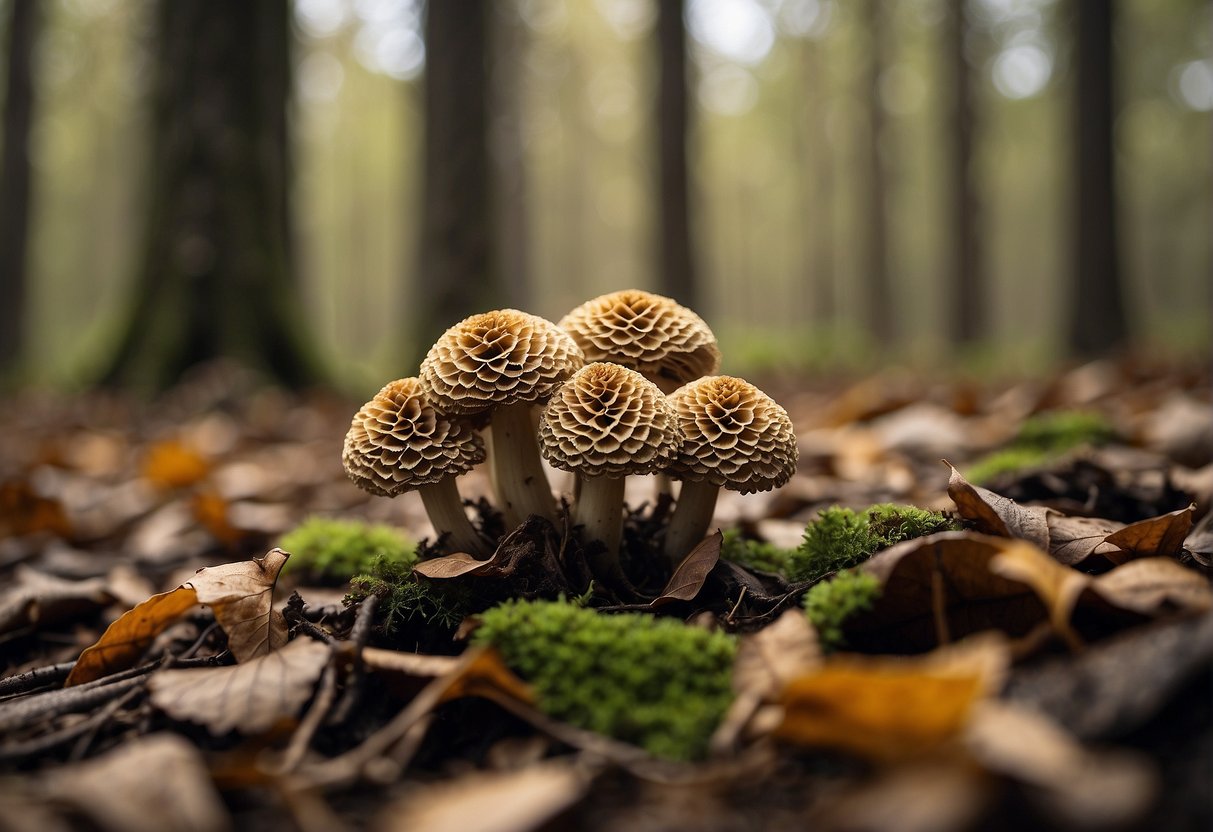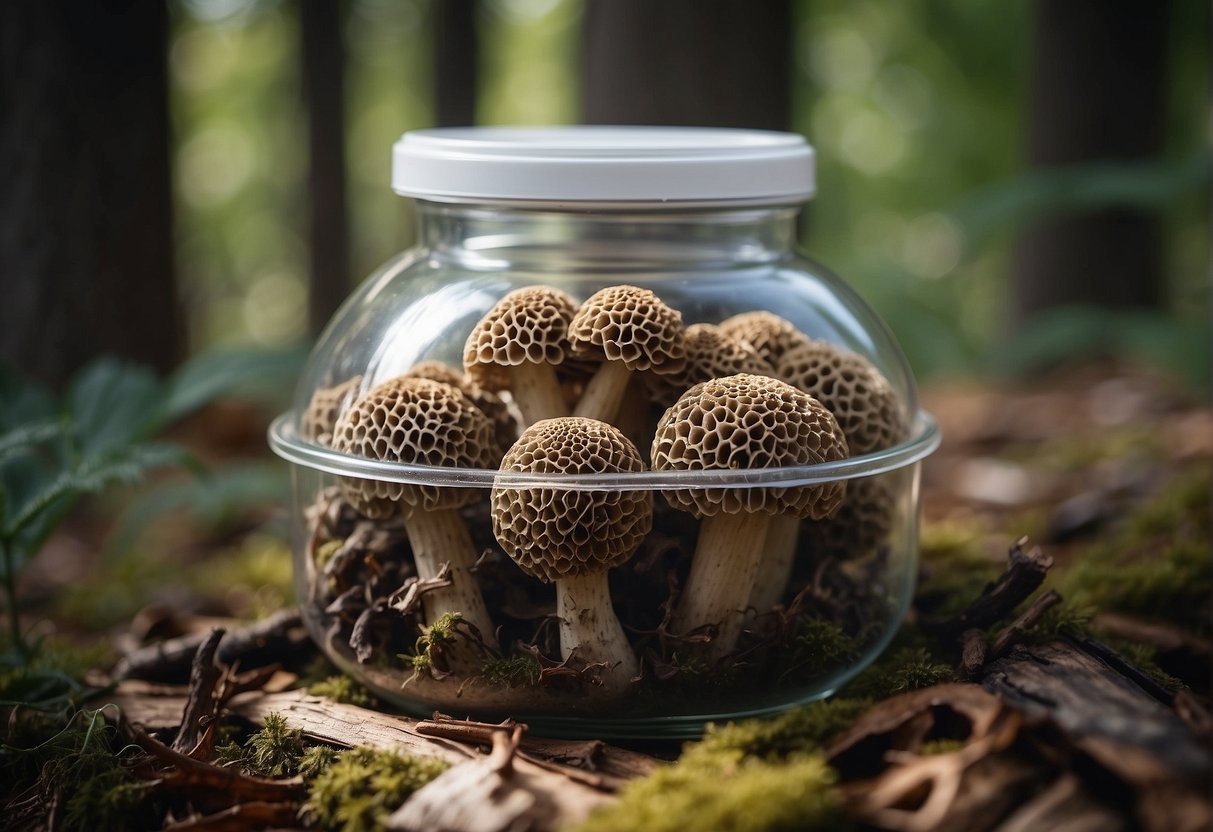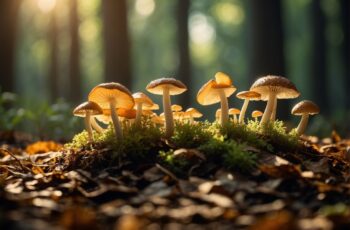As you wander through the forest in spring, your eyes scanning the terrain, the thrill of the hunt pulses through your veins. You’re in search of the elusive and sought-after morel mushroom, a treasure among wild fungi. Known for their distinct appearance and delectable taste, morel mushrooms are a favorite among foragers. With their honeycomb-patterned caps and hollow interiors, they are quite distinguishable from other wild mushrooms, making them an ideal target for both novice and expert mushroom hunters.

The key to successful morel foraging lies in your ability to accurately identify them. Each spring, these fungi make their brief but bountiful emergence, favoring the damp, wooded areas that coat much of the countryside. They often appear around dead or dying trees, thriving in areas disturbed by floods, fires, or logging. Morel mushrooms not only bring the promise of a delicious meal but also the joy of connecting with nature through the time-honored tradition of foraging.
Remember to always verify your finds before indulging, as some morel look-alikes can be harmful. Proper identification is crucial, as is knowing the local seasons and habitats where morel mushrooms flourish. With knowledge and respect for the forest, you can partake in the springtime ritual of morel hunting, enjoying the outdoors and the bounty it offers.
Identifying Morel Mushrooms
When hunting for morel mushrooms, you need to distinguish between the prized edibles and their potentially dangerous look-a-likes. Knowing the details can ensure a safe and rewarding foraging experience.
True Morels vs False Morels
True morels (Morchella spp.) and false morels are often confused due to similarities in habitat and appearance. However, false morels, such as the big red false morel (Gyromitra caroliniana), are toxic. A key distinguishing feature is that true morels have a hollow stem and a continuous attachment from the stem to the bottom of the cap. By contrast, false morels usually have a cottony or chunky interior when split open.
Physical Characteristics
The physical traits of morels are fairly distinctive. Look for fungi with honeycombed caps made up of ridges and pits. The Morchella prava, commonly a true morel, will exhibit these features. The cap should look spongy with networks of ridges surrounding deep pits. A genuine morel’s cap is attached to the stem at the base, unlike some of its look-a-likes.
Ideal Growing Conditions
Morels flourish in environments that are damp yet well-draining. Their appearance after a spring rain is common in wooded areas throughout North America. Look for them under deciduous trees like elms and ashes, especially where the ground is rich in organic matter. Understanding the ideal growing conditions can increase your chances of a bountiful harvest.
Foraging and Harvesting
When you set out for morel mushroom foraging, timing and method are crucial. You’ll want to know when to find these elusive fungi and how to harvest them without harming their natural habitat.
Best Times and Places for Foraging
The peak morel season in North America usually occurs in spring when the soil warms up to around 50 degrees Fahrenheit. During this time, morels can often be found in wooded areas, particularly around ash, elm, and other deciduous trees. They thrive in areas with adequate water and moist soil conditions. For the best results, plan your hunt after a rain, when daytime temperatures are between 60°F and 70°F.
- Early Spring: Soil temperature reaches above 50°F.
- Post-Rain: Sudden warmth after rainfall.
Sustainable Harvesting Practices
As a responsible forager, you should follow sustainable harvesting practices to ensure morels continue to grow in the future. Cut or pinch off the morel at the base rather than pulling it from the ground to avoid disturbing the mycelium. Also, be mindful to forage in areas where it is legally permitted and respect private properties and protected land.
- Harvest with care: Use a knife or scissors.
- Adhere to rules: Forage only in permitted areas.
Cleaning and Preparing Morels
Once you’ve successfully harvested your morels, proper cleaning is essential to remove any debris and insects. Simply rinse the morels in cold water, then soak them in salt water for a short period. It’s important to thoroughly dry the morels before cooking or storing to prevent them from becoming soggy.
- Rinse: Gently wash with cold water.
- Soak: Briefly immerse in saltwater to dislodge insects.
- Dry: Pat dry or use a salad spinner before cooking or storage.
Remember, while morel mushrooms are a delicious and prized find, always identify them correctly to avoid consuming toxic look-alikes. Happy foraging!
Culinary Uses and Recipes
Once you’ve foraged or purchased your big morel mushrooms, unveiling their rich, earthy flavor in your kitchen becomes the next exhilarating challenge. Known for their unique taste, morels are versatile fungi that are treasured in many gourmet dishes.
Cooking Morel Mushrooms
To transform your harvest, sautéing morels in butter is a classic method that enhances their woodsy flavor. When you cook morels, it’s crucial to clean them properly first, as their honeycomb-like structure can conceal grit. For cooking, slice them in half and rinse well. Pat them dry, then cook over medium heat with butter and a pinch of salt until they’re golden and tender to your liking. Always ensure they’re cooked thoroughly, as consuming raw morels can be harmful.
Tasty Morel Recipes
Tapping into the essence of the forest, you can incorporate morels into various recipes to tantalize your palate. Here are a couple of ideas to get you started:
-
Morel Mushroom Risotto: This creamy dish allows the subtle morel flavors to shine amidst arborio rice and Parmesan.
-
Fried Morel Mushrooms: For a crunchier take, coat your morels in seasoned flour, then deep-fry to golden perfection.
Whether you’re preparing a simple sauté or an elaborate feast, remember that morels are highly sought after in restaurants for their unmatched flavor – so enjoy the luxury of preparing them at home. Your kitchen is now your gourmet wilderness.
Safety and Preservation

Before venturing into the woods, know the essentials of morel mushroom safety and the best preservation methods to ensure your foraged finds remain delicious and safe for consumption.
Distinguishing Edible from Poisonous Varieties
Identifying the correct mushroom is crucial. True morels have a honeycomb appearance on their caps and are hollow from the stem to the top. Always look for a solid stem to confirm you don’t have a false morel, which can carry toxins harmful to your health. If unsure, it’s best to consult with an experienced forager or a reliable guidebook before consumption.
Storage and Preservation Methods
Once you’ve safely identified and harvested your morels, proper storage and preservation is key to prolonging their shelf life. Start by gently cleaning your morels with a soft brush or damp cloth; soaking them can cause them to become overly soggy. To preserve, consider these methods:
- Drying: Lay your morel mushrooms on a baking sheet and dry them thoroughly. Once dried, store them in an airtight container away from moisture and light.
- Freezing: If you’d prefer to freeze, first blanch the morels by boiling them for 2-3 minutes, then cool them quickly in ice water, pat dry, and place them in freezer bags. This can keep them suitable for consumption for a number of months.
Remember, never consume mushrooms that haven’t been properly identified or that you’re not confident are safe. Your safety in the wild is paramount, so take the time to understand mushroom varieties and the right way to keep them.


